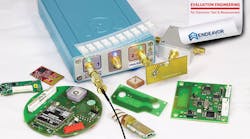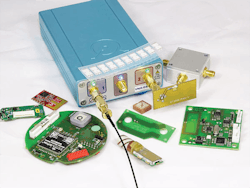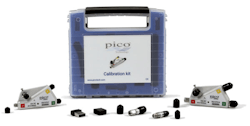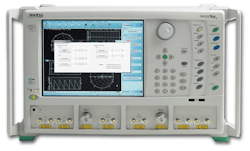This article appeared in Evaluation Engineering and has been published here with permission.
The IoT and related markets for wireless connectivity, coupled by emerging requirements for dielectric measurements in materials science, is driving the need for engineers to add vector network analyzers to their toolboxes. A January report on the topic described VNAs including the Rohde & Schwarz ZNL with A 10.1” WXGA touchscreen and frequency ranges from 5 kHz to 3 GHz or 6 GHz; Keysight Technologies’ line of single-slot PXI VNAs, with the Model M9375A operating from 300 kHz to 26.5 GHz; and the Keysight PNA-X/PNA/PNA-L, with frequency ranges to 1.1 THz.1 Representatives of several companies have elaborated on their VNA products and options—particularly targeting IoT and related applications requiring low cost and ease of use.
“The IoT market is booming,” said Roger Denker, general manager at MegiQ. Consequently, he added, “Engineers need no-nonsense VNAs to get that nasty thing called an antenna to work.” To assist these engineers, MegiQ offers VNAs optimized for the IoT development workflow. Those VNAs include the USB-driven VNA-0460, a 6-GHz 2-port VNA with PC software, as well as the VNA-0460e (Fig. 1), a 6-GHz 3-port VNA with built-in bias tee and bias voltage/current generator to allow parametric measurements.
Denker said the company’s VNAs offer a small form factor and low cost while achieving lab-grade performance, a built-in matching circuit calculator and simulator, color-guided calibration via the front panel, and the ability to create readable (noncryptic) graphic reports. In addition, the instruments make it easy to store/recall full measurements and setups. For space-constrained applications, the company offers calibration kits for U.FL connector-based measurements2 and balanced measurements. To support production testing and other automated tasks, MegiQ offers an application programming interface.
With regard to ease-of-use, Denker said, “We started from scratch to make a user interface for RF developers, adding only useful features.” MegiQ, he added, offers a VNA learning tool called VNA Sandbox—a circuit board that lets users experiment with VNA measurements. A tutorial helps users get started. “MegiQ VNAs are ready to work with out-of-the-box, including adapters and learning tools for developing IoT antennas,” he said. The company offers an application note on contactless antenna measurements in a production environment, describing how a customer achieved high yield at low cost.3
Copper Mountain Technologies offers a line of VNAs that “…gives the user lab-grade performance in a handheld device…” that connects to a processing module via USB, according to Alex Goloschokin, founder and chief revenue officer. He called particular attention to the company’s 1-port VNA (cable and antenna analyzer) line (Fig. 2), including the R60 1-MHz to 6-GHz vector reflectometer. “Our products have a patent (US Patent 9,291,657) that allows the VNAs to connect directly to a DUT without the need for cables,” he said.
Goloschokin also commented on the company’s software, which supports time-domain (including eye-diagram), mixer, and differential measurements; fixture simulation; frequency extension; and other features that come standard. “Our software is free and can be installed on as many computers as needed,” he said, adding that additional post-processing and presentation formats are easily added via custom plugins.
Pico Technology got into the USB VNA market last June with the introduction of the PicoVNA 106 USB-controlled full-function bidirectional vector network analyzer covering 300 kHz to 6 GHz. According to Mark Ashcroft, RF business development manager at Pico Technology, “The ground-up design of a new VNA is so challenging that few are bold enough to attempt it. For those that do, it is not high-cost components and assembly that yield the performance—it is the application of years of experience and attention to detail in all the design aspects: circuit techniques, layout, correction algorithms and math, mechanical packaging, optimized processing, and in this case, use of the PC to do the heavy lifting.”
Commenting on ease of use, Ashcroft said, “The key is to keep the primary user interface clean and simple,” offering direct access to key display channel parameters without diving into menus. “The same is true of the calibration process,” he added, with the instruments providing user instruction.
He emphasized that ease of use does not come at the expense of established advanced user features and benefits. “For example, reference plane shift, de-embedding, all the standard display formats including time domain are all included,” he said, as is support for unknown-thru calibration, the Touchstone import/export format, and P1dB gain compression.
Ashcroft elaborated on calibration. “Essential to any network analysis measurement are the calibration (impedance) standards,” he said. “The instrument and its test leads merely have the role of stable transfer standard with no inherent measurement accuracy of their own. The standards and the test leads again have typically been very expensive essentials.” Pico, he said, rethought the realization of high-performance calibration standards and offers short, open, load, and thru (SOLT) calibration standards and test leads in both PC3.5 and SMA formats (Fig. 3). Residual directivity of typically -50 dB and uncorrected port match of typically -20 dB make the PicoVNA 106 and its premium calibration standards a formidable performance combination at low cost, he said.
Ashcroft cited additional applications for VNAs, including dielectric measurements, penetrating radar, and imaging, be it ground, tissues, foods, or engineering materials. “In these arenas, the embedded VNA is increasingly common and the USB-controlled instrument is ideal,” he said. Similarly, Goloschokin at Copper Mountain has cited materials testing applications.
“Materials testing is a growing application of VNAs, particularly USB VNAs, which can be incorporated into test systems due to their size and portability,” he said.4 He cited interest in an airplane canopy system demonstrated at the company’s booth at last year’s International Microwave Symposium in Honolulu.
Tektronix has also recently entered the USB VNA market with the introduction of the TTR500 Series (Fig. 4). Dylan Stinson, product manager for RF products at Tektronix, said, “The TTR500 Series offers a full 2-port, 2-path S-parameter VNA for such applications as measuring passive/active components, antennas and matching networks, RF modules, test cables, adapters, and more. It features a solid set of specifications including 100-kHz to 6-GHz frequency range, 122-dB dynamic range, less than 0.008 dB trace noise, and -50 to +7 dBm output power, all in a compact package weighing less than four pounds.”
He said the instrument comes with a built-in bias tee accessible on both ports to provide DC bias voltage for active devices such as amplifiers. “No longer will users need to contend with an external bias tee or pay a premium for an instrument with an optional internal bias tee,” he said. “The TTR500’s built-in bias tee allows for 0 to ±24 V and 0 to 200 mA on both ports for active devices.” The instrument, he added, also comes with an assortment of accessories such as calibration kits, rack-mount kits, transit cases, cables, and adapters.
Stinson also commented on software issues, including Tektronix’s VectorVu-PC. “The TTR500 works with any Windows PC or laptop, and the VectorVu-PC software delivers a traditional look and feel for controlling and calibrating the instrument,” he said. “It offers full point and click usability with the ease of PC-based networking for saving and sharing files. For automated test systems in design or manufacturing, VectorVu-PC offers programmatic support for SCPI commands, including command compatibility with common legacy VNAs for easy integration into existing test systems. The software also offers an offline mode for data analysis with an output file format compatible with common EDA simulation tools.”
Anritsu has been addressing higher frequencies with its VectorStar and ShockLine VNAs, both of which employ the company’s patented Nonlinear Transmission Line (NLTL) technology, according to Stanley Oda, ShockLine product manager, and Steve Reyes, VNA product manager. VectorStar (Fig. 5), Reyes said, utilizes NLTL-based samplers in both the baseband unit that operates up to 70 GHz and in the broadband unit that extends frequency coverage to 110/125/145 GHz. “This helps to achieve a much higher instantaneous bandwidth for high dynamic range at mmWave frequencies,” Reyes said.
“The small size and lightweight high-frequency reflectometers in the broadband configurations enhance maneuverability and probe positioning in applications such as on-wafer measurements and near-field scanning of antennas and circuits. Connecting the reflectometer directly to a wafer probe enhances raw directivity, calibration stability, and port power.” He added, “VectorStar offers the ability to measure mmWave noise figure up to 125 GHz and 145 GHz utilizing the NLTL direct access receivers in the broadband configurations.”
“Integration of NLTL in the ShockLine VNAs extends operating frequency to 92 GHz, while it also reduces instrument cost, enhances accuracy, and minimizes measurement uncertainty,” said Oda. “Additionally, the ShockLine family features ‘headless’ instruments with no touchscreen or keypad, so the VNAs are more compact, robust, and easy to integrate into test systems,” he added.
“ShockLine comes in many different frequency ranges (from 50 kHz to 92 GHz), form factors (USB, 1U, 2U, and 3U), and capability levels to match customers’ needs,” Oda continued, adding that advanced time-domain capabilities, direct-access loops, bias tees, and other options are available to further configure ShockLine VNAs for specific applications. “For example, the ShockLine MS46522B VNA has an E-band option that brings banded mmWave measurement capabilities to an economic cost level,” he said. “The E-band VNA consists of small tethered source/receiver modules and a base chassis. The modules are attached to the chassis through 1-meter cables that are permanently attached to the unit, eliminating the need for any user setup of cables between the VNA and the measure modules. Tethered modules connect directly to the DUT for increased measurement stability.”
Conclusion
At present, VNAs operating in the 6-GHz range are hitting the sweet spot of IoT designs requiring low-cost, easy-to-use instruments. But as Oda pointed out, the emergence of 5G applications will drive demand for 28 GHz, 39 GHz, and 60 GHz VNAs in 2018 as 5G-related devices gain traction in the marketplace. In addition, he said, VNAs play a vital role in connected-car designs, with radar systems operating at 76 to 81 GHz and infotainment systems operating at high data rates. Finally, Oda said, “Along similar lines, high-speed network systems operating at 100G/400G present an opportunity for VNAs, which can be used to conduct O/E and E/O measurements.”
References
- Nelson, Rick, “IoT, 5G, connected cars drive VNA applications,” EE-Evaluation Engineering, January 2018, p. 6.
- “Using UFL as Test Connectors,” Application Note, MegiQ, 2013.
- “Using contactless antenna measurement in a production environment,” Application Note, MegiQ, 2016.
- Nelson, Rick, “CMT founder makes the case for USB vector network analyzers,” Rick’s Blog, EE-Evaluation Engineering Online, July 27, 2017.





